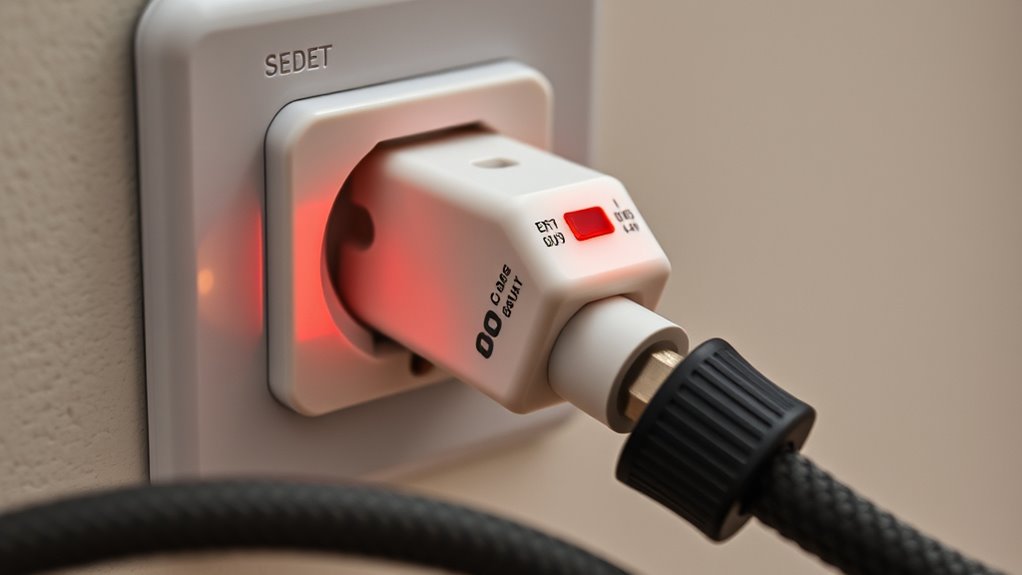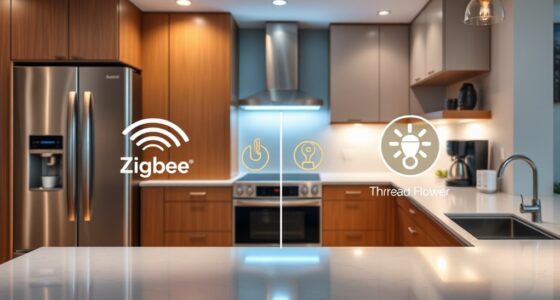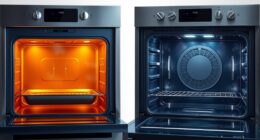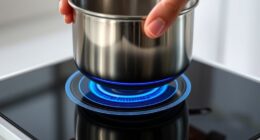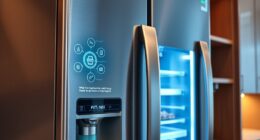When using smart plugs with high‑draw devices, it’s vital to respect their power ratings, typically supporting around 15A or 1800W at 120V. Always check the device’s wattage and current draw against the plug’s limits, and verify the plug has safety certifications like UL or ETL. Overloading or chaining multiple high‑power devices can cause overheating and fire hazards. To stay safe and guarantee longevity, understand these limits and explore advanced options if needed. More details follow.
Key Takeaways
- Ensure smart plug’s rated current and wattage match or exceed your device’s power requirements to prevent overheating.
- Use certified smart plugs (UL, ETL, VDE) designed for high loads with surge, overvoltage, and undervoltage protections.
- Avoid exceeding 80-90% of the smart plug’s maximum rated capacity for continuous high‑draw device operation.
- Be cautious with inductive loads; choose smart plugs with surge handling and high inrush current ratings.
- Regularly inspect for signs of overheating or damage, and do not overuse smart plugs for prolonged high‑power devices.
Understanding Power Ratings and Limits
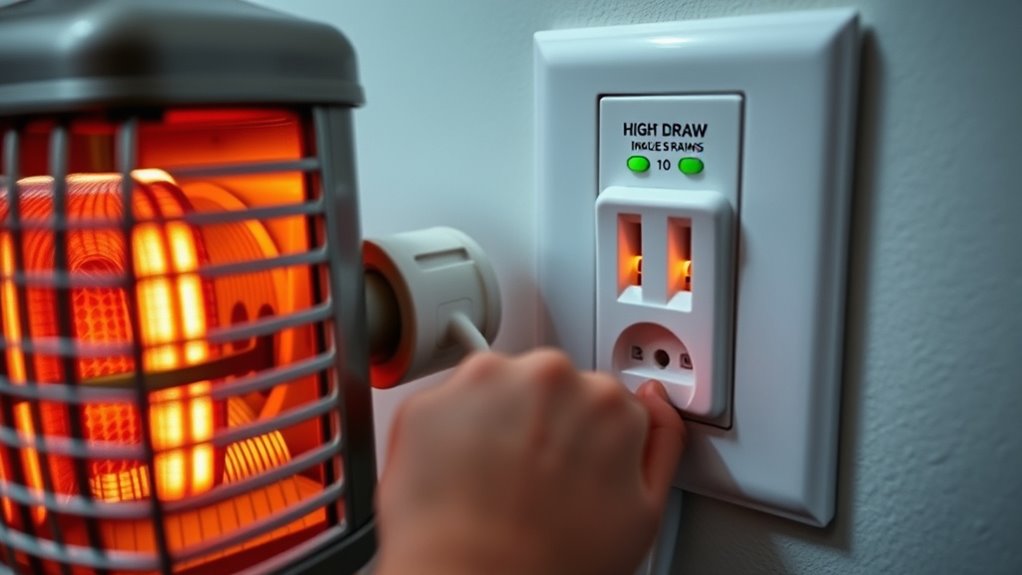
To safely use smart plugs with high‑draw devices, it’s essential to understand their power ratings and limits. Most North American smart plugs handle about 15 amps for spikes and 10 amps for continuous use over an hour, supporting roughly 1,800 watts safely. UK and EU plugs typically have similar limits but operate at 240V, affecting wattage capacity. Exceeding these ratings risks overheating, damage, or fire. Heavy-duty smart plugs can manage 20 to 30 amps but are more costly and specialized. Remember, spike current is brief and usually tolerable, but sustained loads above the rated continuous current can cause overheating and reduce the plug’s lifespan. Always verify your device’s power requirements and match them within the plug’s specified limits for safe operation.
Selecting the Right Smart Plug for Heavy Appliances
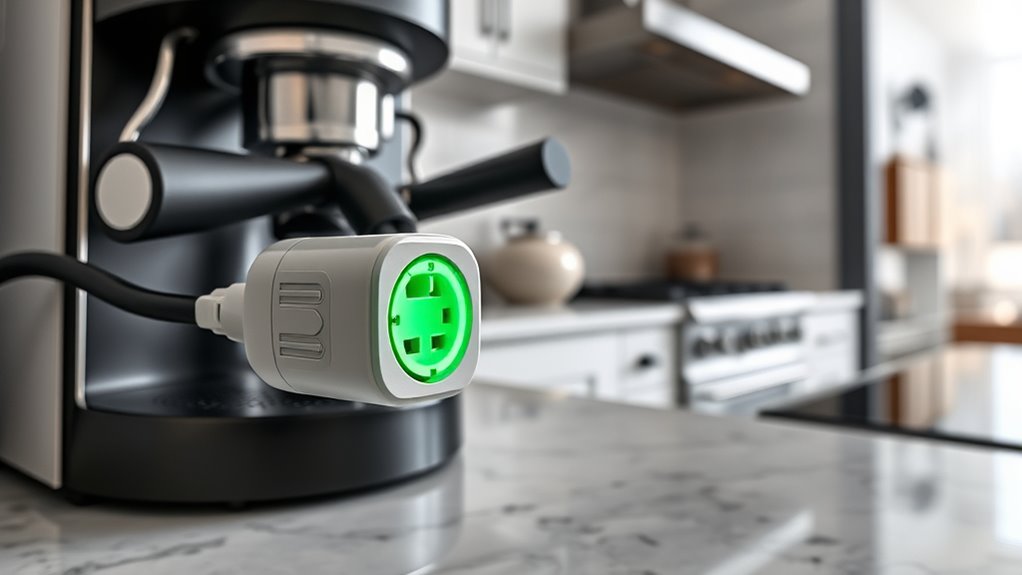
When choosing a smart plug for heavy appliances, you need to verify its power ratings to guarantee it can handle your device’s draw. Matching the load type and amperage is vital for safe, reliable operation. Don’t forget to check for safety certifications like ETL to confirm the plug meets essential safety standards. Heavy-duty smart plugs are specifically designed to support higher current loads and are essential for appliances that draw 20 amps or more. Ensuring your smart plug has the appropriate load capacity can prevent potential electrical hazards and prolong the lifespan of your devices. Additionally, understanding dog breeds and their specific needs can help you choose appliances that are suitable for your household and pet safety.
Verify Power Ratings
Before plugging in a heavy appliance, you need to verify that the smart plug’s power ratings match the device’s demands. Check the appliance’s wattage and current specifications, typically found on its label. Standard smart plugs support around 10 to 15 amps, which equals roughly 1800W at 120V or 3700W at 230V. For heavier appliances drawing over 15 amps, you’ll need a smart plug rated for at least 15 amps or more, depending on the load. Make sure the plug’s maximum resistive or motor load ratings align with your device’s requirements. Also, confirm that the smart plug is certified by safety standards like UL or ETL, ensuring it can handle the load safely without overheating or failure. Understanding the horsepower of electric dirt bikes can help determine the appropriate load capacity for high-demand devices. Additionally, consider the air purifier’s coverage area to ensure your smart plug can support all connected devices effectively.
Match Load Types
Choosing the right smart plug for heavy appliances depends on understanding their load types and how they draw power. Resistive loads like heaters and incandescent bulbs draw a steady current, making them easier to manage with standard smart plugs. Inductive loads, such as refrigerators and washing machines, create a phase shift and have high inrush currents during startup—often three to seven times their steady current. These require smart plugs that can tolerate surge currents without tripping or overheating. Capacitive loads are rare in household appliances but can affect startup currents. When selecting a smart plug, make certain it can handle peak surge and continuous currents specific to your appliance’s load type. Proper matching prevents premature failure and ensures safe, reliable operation. Understanding load characteristics is essential for choosing the appropriate device to handle the specific demands of your high‑draw appliances.
Ensure Safety Certifications
Ensuring that your smart plug has the proper safety certifications is essential for safely powering heavy appliances. Certifications like UL and ETL guarantee the device meets strict safety and performance standards, especially for high-current loads. Look for certification marks on packaging or datasheets to verify compatibility. Certified plugs undergo rigorous testing for electrical load capacity and fire hazards, ensuring they can handle inrush currents and sustained high currents without damage or risk. Choosing uncertified or cheap foreign brands may expose you to overheating, electrical failures, or voided warranties. Safety standards ensure that the device has been evaluated for safety and compliance. – Imagine a flame-retardant shell protecting against sparks and faults – Nickel-plated contacts ensuring reliable conductivity under heavy load – Compact design with effective thermal dissipation for safety – Recognizable certification marks on packaging verifying heavy-duty compliance
Recognizing Safety Certifications and Standards
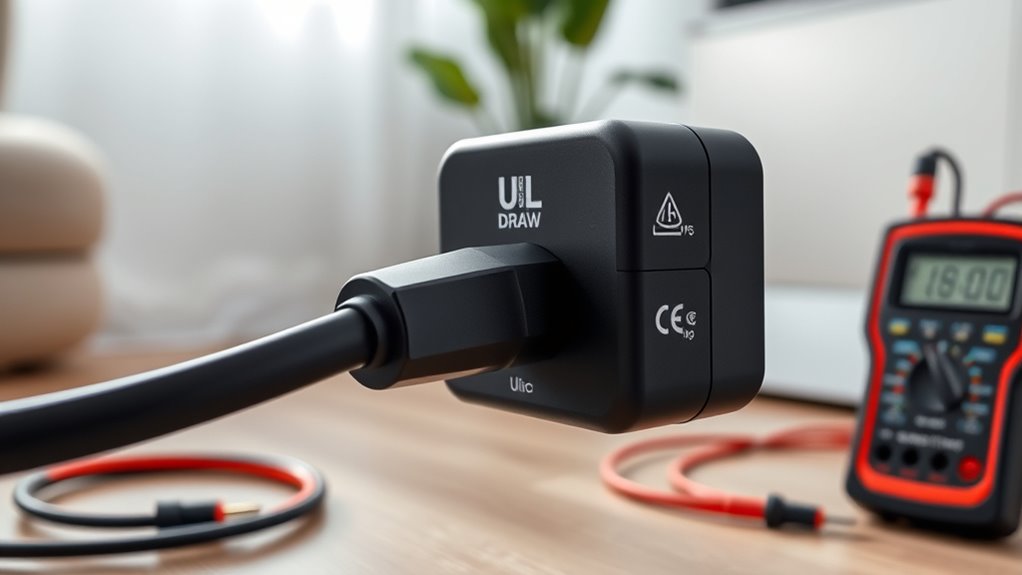
Recognizing safety certifications and standards is essential for ensuring that your smart plug meets regional safety and quality requirements. Certifications like IEC 60884 guarantee global safety, while region-specific labels such as UL (US), BS (UK), or VDE (Germany) confirm compliance with local regulations. These standards cover insulation, mechanical strength, and electrical safety, making sure your device operates safely under high load. Visualize this with the following certifications:
| Certification | Region | Focus Area |
|---|---|---|
| IEC 60884 | Global | Mechanical & electrical safety |
| UL | US | Fire and shock safety |
| VDE | Germany | Electrical safety standards |
| CE | EU | Health, safety, environment |
Matching your smart plug to these standards guarantees safety, legality, and peace of mind.
Adding to this, understanding safety certifications helps ensure that your device has undergone rigorous testing for high‑draw device compatibility and safety compliance. Recognizing safety standards is also important to prevent potential hazards associated with high‑power devices.
Managing Usage Duration and Duty Cycle
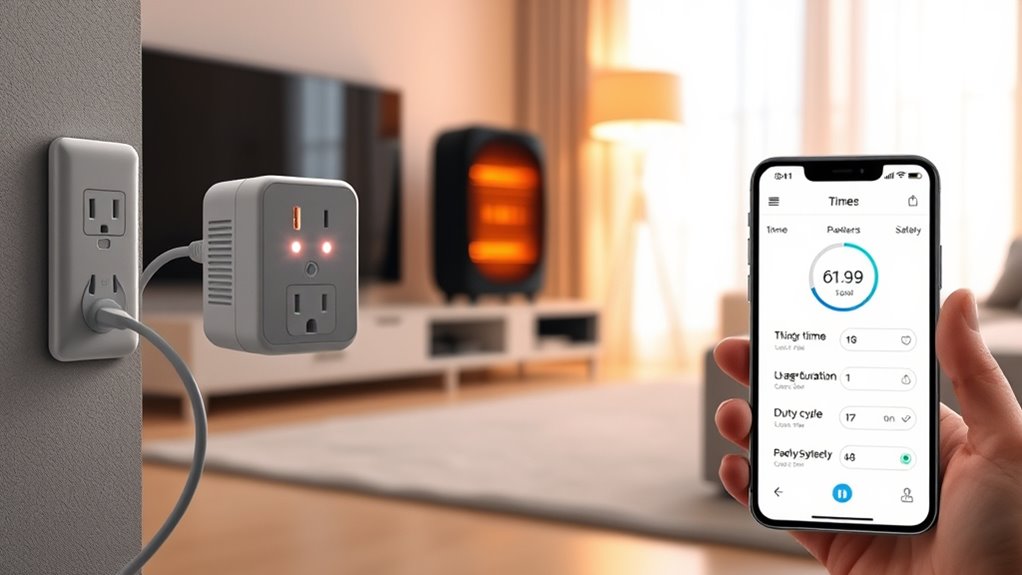
Managing the usage duration and duty cycle of your high‑draw devices is essential to prevent overheating and extend the lifespan of your smart plug. Limiting continuous operation to about 3 hours at full load helps avoid heat buildup that can damage the device. Using automation or control apps, you can enforce rest periods between cycles, reducing thermal stress. To visualize, consider:
- Running space heaters in shorter bursts, then allowing cooling
- Scheduling microwave use within safe time limits
- Implementing timers to turn off devices automatically
- Avoiding simultaneous high-wattage appliances on the same outlet
These practices help maintain safe operating temperatures, prevent smart plug shutdowns, and prolong device longevity. Regular monitoring and smart control ensure you stay within safe duty cycles, reducing risks of damage or failure. Incorporating space‑heating basics into your safety strategy can further optimize device performance and lifespan, especially when managing electrical load effectively.
Compatibility With Resistive and Inductive Loads
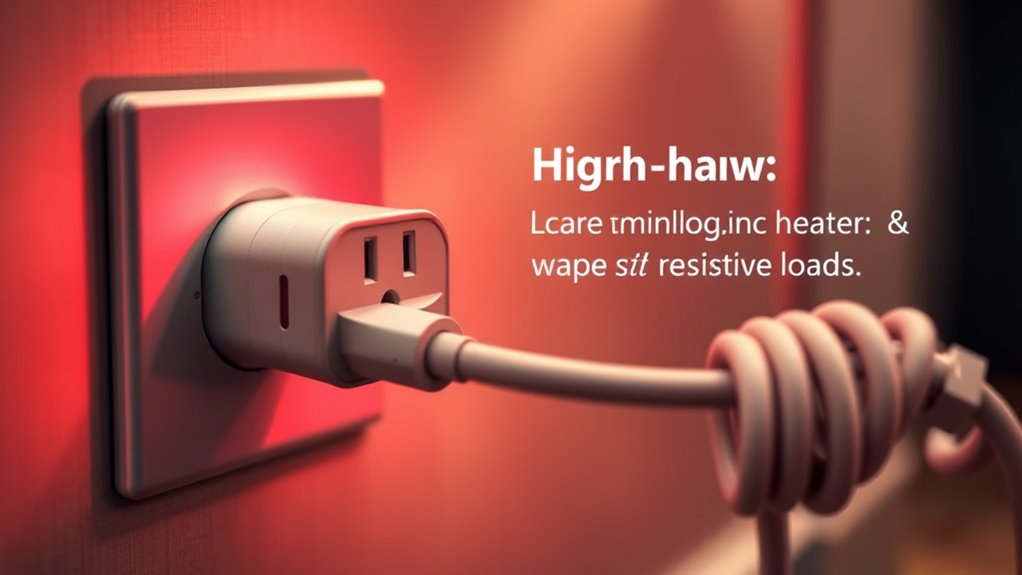
When choosing a smart plug, you need to take into account whether your device is resistive or inductive, as each type impacts compatibility. Resistive loads like heaters are generally straightforward, but inductive loads like motors and fans can cause issues if the plug isn’t rated for them. Always check the specifications to make certain your smart plug can handle the load type and wattage safely. Additionally, understanding AI in Business can help you make smarter decisions about integrating technology into your home automation systems, ensuring safety and efficiency.
Load Type Considerations
Smart plugs are generally designed to handle resistive loads like heaters and incandescent bulbs, which draw current proportional to voltage and cause minimal stress on the device. Inductive loads—such as motors, pumps, and fans—contain coils that create magnetic fields, leading to current phase shifts and high inrush currents at startup. These surges can be 5 to 7 times higher than running current, stressing the relay contacts and internal components.
- Imagine a motor starting suddenly, drawing a surge far beyond normal, risking relay damage
- Visualize a pump turning on with a jolt, pushing relay contacts toward welding or overheating
- Think of a fan’s initial burst of energy, potentially exceeding the rated capacity of your smart plug
- Picture a compressor’s powerful startup, which may trip or damage unprepared devices
- Be aware that some headphones may have complex internal components that could be affected by sudden power surges during startup.
Load Compatibility Guidelines
Understanding load compatibility is essential to guaranteeing your smart plug operates safely and effectively with different appliances. For resistive loads like heaters, irons, or toasters, make certain the device’s power consumption doesn’t exceed about 3.5 kW, and use a smart plug rated for at least 10 A to 16 A. These loads draw steady current, so special surge handling isn’t typically needed. For inductive loads such as motors, pumps, or air conditioners, your smart plug must support higher peak currents and be rated for at least 16 A to handle startup surges safely. Look for plugs with overvoltage, undervoltage, and surge protection features. Always verify your appliance’s power specs and choose a certified smart plug that matches or exceeds the load requirements to prevent hazards. Incorporating safety features like thermal cutoffs can further enhance protection during operation. Regular maintenance and monitoring can help ensure continued safe operation with various loads.
Precautions for Continuous High-Load Operation

Continuous high-load operation of smart plugs demands careful precautions to prevent overheating, electrical failure, and fire hazards. You should avoid exceeding the rated current for extended periods, especially with 15-amp smart plugs used continuously for more than 3 hours. Using a smart plug with a safety margin of at least 25-33% above your device’s draw helps prevent overheating. Ensure the plug has UL, ETL, or similar certification for safety standards. Select models with built-in overheat protection, thermal cutoff switches, and proper ventilation. Protect your devices with surge protection rated for continuous use, and verify voltage compatibility. Regularly inspect plugs for signs of wear or damage, and replace them promptly to avoid electrical or mechanical failure during prolonged high-load operation. Supporting safe usage with digital literacy can help users understand and manage electrical safety risks more effectively. Additionally, understanding electrical load management can aid in optimizing device performance and safety during extended high-power usage.
Physical Design and Installation Considerations
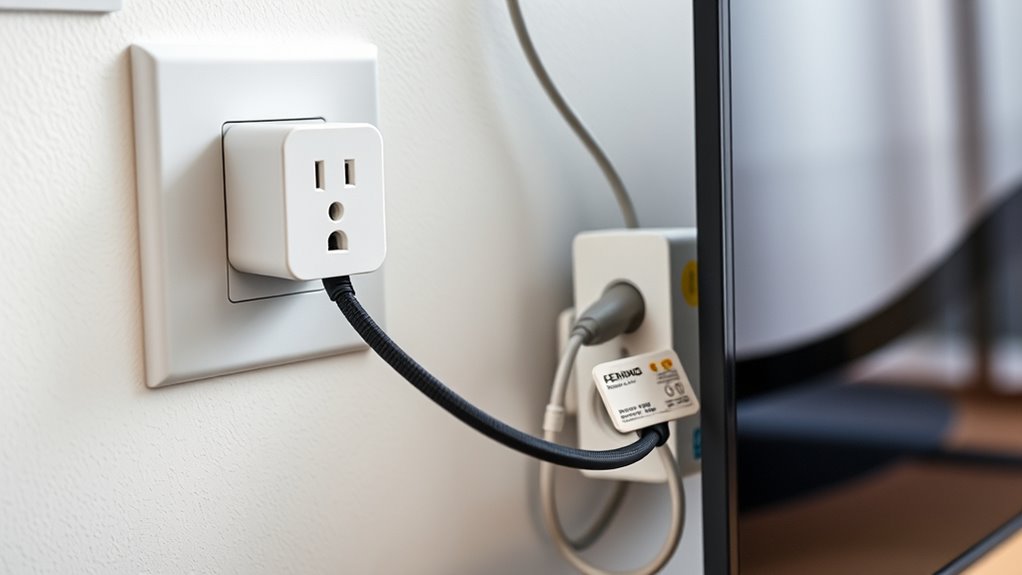
When designing and installing high‑draw smart plugs, guaranteeing that their physical form factor and internal layout meet safety and functionality standards is essential. You should select a compact, slim design that prevents blocking adjacent outlets, allowing multiple devices to connect simultaneously. Shape choices like rounded rectangles help optimize space and improve ergonomics. Internal components, such as PCBs for power, relay, and wireless functions, need careful arrangement to prevent overheating and facilitate heat dissipation. Use heat-resistant, flame-retardant materials like UL94-V0 plastics to reduce fire risks. Ensure proper soldering and secure connections between PCB layers to maintain device integrity. Additionally, consider button placement and LED indicators for easy manual operation and status visibility, especially when multiple plugs are installed side-by-side. Incorporating AI-powered safety features can further enhance device protection by monitoring temperature and load conditions in real-time. Paying attention to physical design standards ensures that the smart plug remains safe and reliable over its lifespan.
Avoiding Overloading and Daisychaining Devices
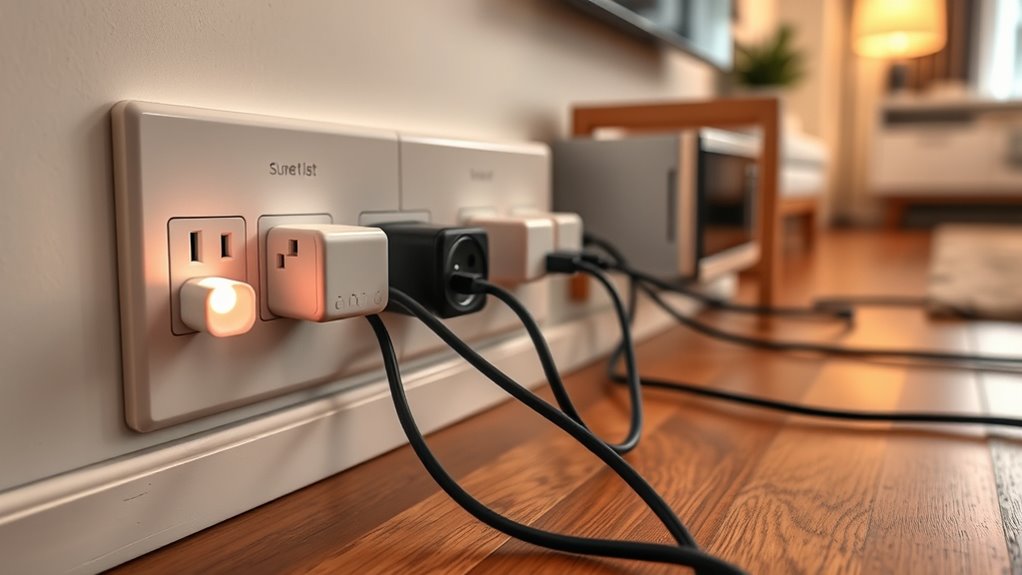
Overloading smart plugs or daisychaining devices can cause serious safety hazards, including overheating, electrical fires, and damage to appliances. When you connect too many high-power devices or chain multiple cords, you risk exceeding the rated current, leading to dangerous heat buildup. To avoid this:
- Imagine a plug overheating as it struggles to handle the load, risking a fire.
- Visualize a smart plug frying or breaking due to overload.
- Picture a wiring system damaged from sustained high current.
- Consider the danger of a fire igniting from overloaded outlets and cords.
Always check your device’s current draw and match it with your smart plug’s capacity. Never daisychain extension cords or multiple smart plugs, and consider dedicated circuits for high-draw appliances to stay safe.
Monitoring and Maintaining Safe Operation
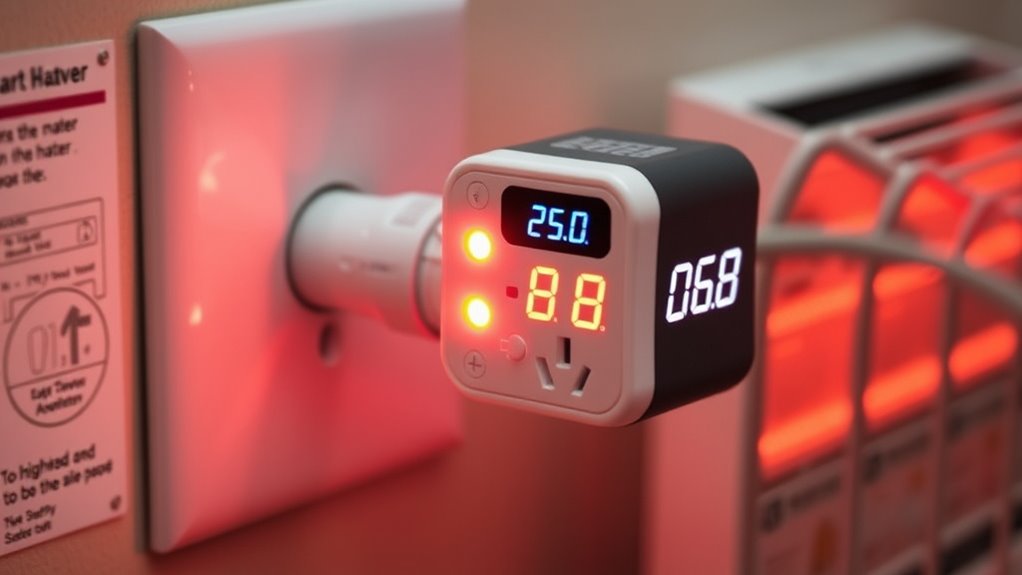
You should regularly check your smart plug for any signs of overheating, such as discoloration or a strange smell. Keep an eye on the device during operation to catch any early warning signs of trouble. Taking these simple steps helps guarantee your high‑draw devices stay safe to use. Additionally, ensure the smart plug’s power capacity aligns with the device’s energy requirements to prevent overloads. Being aware of advances in AI safety can also help in choosing smarter, more reliable devices that incorporate protective features.
Regular Temperature Checks
How can you guarantee high‑draw devices operate safely with smart plugs? Regular temperature checks are essential. They make sure your devices stay within safe limits and prevent overheating. Use dedicated sensors or external WiFi-enabled devices to monitor temperature continuously. Keep an eye on real-time data via apps or cloud services for immediate insights. Perform routine inspections for dust, damage, or sensor malfunctions that could skew readings. Ensure sensors are properly calibrated and functioning correctly. Set automated alerts for temperature deviations, so you’re notified before issues escalate. Maintaining accurate, ongoing temperature data helps you identify trends indicating potential risks. Kia Tuning can also be considered when tuning high‑performance components to ensure thermal safety. This proactive approach keeps your high‑draw appliances operating safely, reducing the chance of thermal damage or failure. Remember, consistent monitoring is key to safe, reliable use.
Observe for Signs of Overheating
Monitoring your high‑draw devices with regular temperature checks helps prevent overheating, but it’s equally important to observe for physical signs that indicate unsafe operation. Look for discoloration around outlets or plugs, such as brown or black marks, which signal heat damage or melting. Listen for unusual noises like crackling, buzzing, or popping, which can indicate loose connections or arcing. Smell for burning or acrid odors, as these suggest insulation degradation or wiring faults. Visually inspect for warped, cracked, or melted plastic parts, and check if cords feel hot or have softened insulation. These signs often appear before a fire hazard occurs. Promptly addressing any of these indicators can prevent serious damage, electrical shocks, or fires. Stay vigilant and act quickly if you notice these warning signs.
When to Use Hardwired Solutions or Smart Breakers
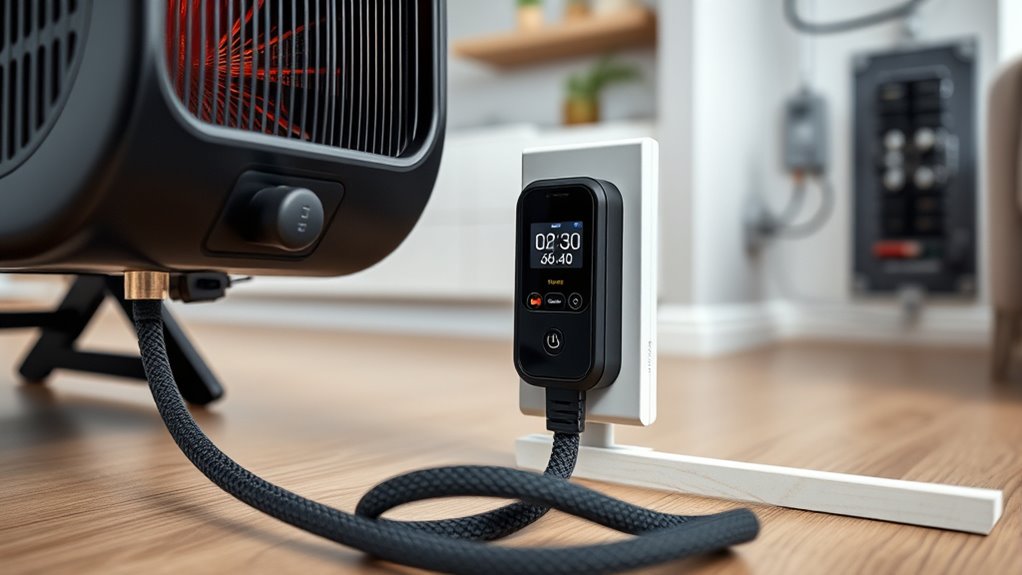
High-draw appliances such as refrigerators, dishwashers, and washer-dryers often exceed the capacity of standard smart plugs, making hardwired solutions or smart breakers the safer choice. These appliances typically draw 20 amps or more, surpassing most smart plug limits and increasing fire risk. Hardwired smart breakers and outlets are designed for higher current loads, offering better heat dissipation and durability. They integrate directly into your electrical panel, providing circuit-level control and overload protection. Consider these factors:
For high-draw appliances, hardwired smart breakers offer safer, more reliable control and protection.
- Envision a sturdy breaker box with multiple circuits, each managing heavy-duty appliances.
- Think of a neatly installed hardwired outlet, free from loose connections or overheating.
- Picture a smart breaker system monitoring multiple devices simultaneously.
- Visualize a professional electrician ensuring proper wiring, reducing fire and damage risks.
Frequently Asked Questions
Can I Use a Standard Smart Plug for a Refrigerator?
No, you shouldn’t use a standard smart plug for a refrigerator. Refrigerators often draw 20 amps or more, and standard smart plugs rated for 10 to 15 amps aren’t designed to handle that kind of load. Using one could overload the plug, cause damage, or even start a fire. Instead, opt for a heavy-duty smart plug rated for at least 20 amps, or consider dedicated smart appliances designed for high-current loads.
How Do I Know if My Smart Plug Supports Motor Loads?
You can’t risk your smart plug turning into a disaster! To know if it supports motor loads, check the manufacturer’s specs for high current ratings—look for at least 15A or 16A—and confirm it’s rated for inductive loads like motors or fans. Search for certifications like UL, and see if the product mentions support for motors or high inrush current. If unsure, don’t use it—safety comes first!
Are Outdoor Smart Plugs Safe for High-Power Appliances?
Outdoor smart plugs are generally safe for low-to-moderate power appliances like landscape lights or pool pumps, provided they stay within the rated capacity, usually around 15 amps or 1800 watts. However, avoid using them with high-power devices like large heaters or electric grills unless the plug explicitly supports such loads. Always check the device’s wattage and amperage, and follow the manufacturer’s safety guidelines to prevent overheating or damage.
What Are Signs of an Overloaded or Unsafe Smart Plug?
You’ll notice signs like flickering or dimming lights, which suggest overload. If the smart plug feels warm or hot, it’s a warning sign of overheating. Buzzing sounds or crackling indicate loose connections or arcing. Discoloration or scorch marks show excessive heat buildup. Frequent circuit breaker trips, unexplained device resets, or power surges also point to unsafe conditions. If you see any of these signs, stop using the plug immediately to prevent hazards.
Can I Leave High-Draw Devices Plugged in Overnight Safely?
You can’t leave high-draw devices plugged in overnight safely unless your smart plug is rated for continuous, high-capacity use and has built-in safety features like overheat protection. Most standard plugs aren’t designed for this, risking overheating or circuit overloads. For safe overnight operation, opt for specialized high-current smart switches, guarantee proper circuit capacity, and use energy monitoring to catch any issues early. Always prioritize safety and follow manufacturer guidelines.
Conclusion
Remember, while smart plugs offer convenience, respecting their limits keeps your home harmonious. By choosing wisely, monitoring carefully, and avoiding overstretching, you guarantee your devices serve you well without unintended strain. Sometimes, the most seamless solutions are those that gently honor boundaries, quietly maintaining balance. Trust in thoughtful choices and subtle safeguards—they help your smart home flourish quietly and safely, allowing peace of mind to become your silent partner.
